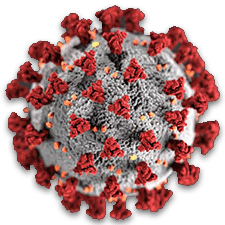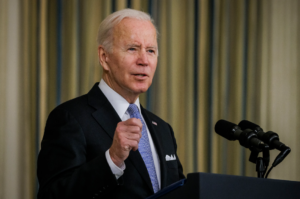For Experts Who Study Coronaviruses, a Grim Vindication
10 min read
The now prophetic words could be found buried at the end of a research paper published in the journal Clinical Microbiology Reviews in October of 2007: “The presence of a large reservoir of SARS-CoV-like viruses in horseshoe bats, together with the culture of eating exotic animals in southern China, is a time bomb.”
The warning — made nearly 13 years ago and more than four years after a worrying first wave of severe acute respiratory syndrome, or SARS, killed nearly 800 people globally — was among the earliest to predict the emergence of something like SARS-CoV-2, the virus behind the current pandemic of Covid-19.
Many other warnings would follow.
Indeed, evidence of a looming and more deadly coronavirus pandemic had been building for years, but experts who specialize in coronaviruses — a large family of pathogens found especially in birds and mammals that can cross over from other mammals to humans and cause varying degrees of illness — struggled to convince a broader audience of the risk. Dogged by skepticism and inconsistent funding, these coronavirus researchers say they were stymied from developing treatments and vaccines for SARS — many of which could have been helpful in the current crisis. Much about what we learned about SARS would have applied now, according to Michael Buchmeier, a virologist at the University of California, Irvine. “The viruses are so similar.”
Those lessons, however, were long delayed — in part because predicting the next pandemic is hard business, and support for infectious diseases preparedness was leaning elsewhere. Both SARS and its far deadlier coronavirus cousin, Middle East Respiratory Syndrome (MERS), were understood to be threats. But other coronaviruses cause the common cold, and even the SARS and MERS outbreaks each burned out in less than a year. When those disease cases fell off, public health responders shifted to other viral emergencies such as Ebola and Zika, and coronavirus research funding dropped sharply.
That left many investigators who had been working on therapies for SARS holding the bag — even as laboratories around the world were reporting ominous findings: A number of SARS-like coronaviruses in bats, they had discovered, were only a few simple mutations away from being able to infect human cells.
Whether the world should have heeded the warnings of coronavirus specialists is, of course, a matter of hindsight. But to some experts whose business it is to hunt potential pathogens before they spillover into human populations, the many years spent not girding for a coronavirus outbreak were tragically — and unnecessarily — wasted.
“We were out there on the ground after SARS working on coronaviruses with Chinese colleagues in collaboration,” said Peter Daszak, president of the EcoHealth Alliance, a New York-based non-profit group that took part in a larger, federally-funded effort, called Predict, to hunt for new pandemic viruses in wildlife in 31 countries, including China. That effort was famously defunded last fall, just before the SARS-CoV-2 outbreak began.
“But we were the only group of western scientists,” Daszak added. “How can we be the only people looking for these viruses when there was such a clear and present danger?”
The coronavirus research community has always been small, friendly, and interactive. “A cul-de-sac at the end of the road of virology,” says Buchmeier, who’s been studying coronaviruses since 1980. Scientists were drawn to the field by a shared fascination: Coronaviruses evolved strategies to protect themselves from genetic errors during replication that are unlike any other in the microbial world.
They may induce lethal infections in certain animal species, particularly in cats and pigs. But their reputation in human medicine has long been one of being “wimpy viruses that cause only mild disease,” said Albert Osterhaus, founding director of the Research Center for Emerging Infections and Zoonoses, in Hanover Germany. So, when SARS emerged in late 2002, he added, there was initially “general disbelief among medical people that a coronavirus could be the basis of such a huge outbreak.”
As the epidemic spread, an influx of new researchers crowded the field. More grants were awarded and the funding started to climb. “Everyone wanted to know where the virus had come from,” said Ralph Baric, a microbiologist at the University of North Carolina Gillings School of Public Health. Initial findings pointed to wild civets and racoon dogs sold for meat and pelts, respectively, in Chinese markets. Later evidence began to implicate horseshoe bats as the original source of the infections. Some researchers whose careers before SARS were grounded in basic coronavirus biology began working on therapies and vaccines — and they made steady progress for several years.
But after increasing from a low of 28 in 2002 to a peak of 103 in 2008, the number of grants funded by the National Institutes of Health for coronavirus research went into a tailspin. “Also, the people went away,” said Susan R. Weiss, a virologist at the University of Pennsylvania’s Perelman School of Medicine. “They rush in and they rush out.”
To be sure, some researchers working with larger, multi-investigator grants retained their support. Baric and his collaborator Mark Denison at Vanderbilt University, for instance, kept their funding and went on to repurpose remdesivir, originally developed to treat hepatitis C, but now the first approved drug for Covid-19 for emergency use.
But according to Linda Saif, a virologist and mucosal immunologist at Ohio State University, in Wooster, the funding declines hobbled individual investigators who weren’t part of these larger consortia. Pharmaceutical companies that develop vaccines and therapies scaled back on coronavirus research, too, and within just a few years after the SARS outbreak, public health funding agencies both in the United States and abroad “no longer regarded coronaviruses as a high public health threat compared to other diseases,” Saif wrote in an email to Undark.
Saif herself had been studying the respiratory consequences of giving steroids to coronavirus-infected pigs, whose symptoms mirror those of SARS patients. After coronavirus was deemed not to be a significant human pathogen, “it was very hard to get funding to keep going in that area,” she said. Another similarly affected researcher was Brenda Hogue, a virologist at Arizona State University, in Tempe. Hogue had devoted her career to studying coronaviruses, focusing on the protein machinery that drives their assembly. After SARS, she and her colleagues turned part of their attention towards developing a vaccine. But when the funding dropped off in 2008, the vaccine went into limbo “and we put our efforts into other directions,” Hogue said.
Though support for coronavirus research spiked a bit with the MERS outbreak in 2012, the increase was short-lived. Since the outbreak was quickly contained, the disease didn’t raise wider concerns, and grant opportunities declined further.
Ironically, just as funding for drugs and vaccines was drying up, evidence that other coronavirus threats lurked in wildlife was only getting stronger. Scientists had for years been finding viral strains in bats and other animals that were genetically similar to the virus behind the SARS epidemic. But sequence data has its limits. To demonstrate that a virus is actually harmful to people, scientists need to isolate and culture the microbe and show it infects human cells in the lab. Coronaviruses initiate infections by using the spikey proteins jutting from their surfaces to bind with receptors on their target prey. And SARS-CoV uses its spike protein to bind with a specific receptor called ACE2, which normally helps to regulate blood pressure.
Ten years would pass, however, before researchers could show there were other SARS-like viruses in nature that also bind with ACE2. The evidence came from a team based at the Wuhan Institute of Virology, which was the first to isolate a SARS-like virus from horseshoe bats. Led by virologist Zheng-Li Shi, the Wuhan team reported in 2013 that this particular virus, called WIV1, binds with ACE2 in civet and human cells, and then replicates efficiently inside them. “That was the red flag,” Saif said. Earlier evidence suggested that direct contact with these bats could lead to viral spill over in humans. “Now there was proof of that.”
The bats had been trapped in a cave in Kunming, the capital of Yunnan Province. At least seven other SARS-like strains were present in that same colony, leading the researchers to speculate that bat coronaviruses “remain a substantial global threat to public health.”
In addition to culturing WIV1, the Wuhan team also sequenced two other SARS-like strains in bat feces, including one called SHC014. They didn’t culture the microbe, but Baric and his colleagues did explore its infectious potential with an experiment: They created a hybrid microbe by attaching the spike protein from SHC014 to the genetic backbone of a SARS-like virus that was previously adapted to grow in mice. Called a chimera — an organism containing cells with more than one genotype — this lab-made microbe had no problem binding with ACE2 and infecting human cells. Baric’s research team concluded that like WIV1, any SARS-like viruses outfitted with the SHC014 spike could pose cross-species threats to people.
Some conspiracy theories currently circulating allege that a chimera may have escaped from high-security labs at the Wuhan Institute of Virology and caused Covid-19 — and Baric acknowledged the risky nature of the research. “In general, we don’t know the transmissibility or virulence potential of any bat viruses or chimeras,” Baric said in an email message. “Hence it’s best to keep and work with them under biosafety level 3 laboratory conditions to maximize safety.”
 | Thoughts or questions on Covid-19? See our full coverage, or email us at [email protected]. |
Still, Baric points out that a chimera would display a genetic signature “that says what it is.” The adjoining parts of a chimera segregate discreetly in a logical pattern. A genetic analysis of the chimera produced in his lab, for instance, “would come out to be mouse-adapted SARS everywhere but the spike, which is SHC014.” Similar logical patterns are absent in SARS-CoV-2, indicating that the virus evolved naturally.
Conspiracy theories aside, even as Baric and others were generating lab evidence that more SARS-like viruses were poised for human emergence, another outbreak — in pigs, not people — provided another strong and recent signal: Some 25,000 piglets were killed by a coronavirus in Guangdong Province, China, starting in 2016. That virus, too, was found in horseshoe bats, and Buchmeier describes the outbreak as both a major cross-species spill-over and a warning shot that was never really picked up by the broader public health community.
“They called it an agricultural virus,” he said, “and didn’t consider it as predictor of something that could happen in a human disease.”
Buchmeier emphasizes that responders could have devoted more efforts to look for coronaviruses in animal markets following the outbreak in swine. But as fate would have it, funding trends were headed in precisely the opposite direction. Federal funding for the Predict surveillance program was terminated in September 2019, only months before the Covid-19 pandemic began.
The EcoHealth Alliance, which had been part of the Predict effort, maintained its own collaboration with the Wuhan Institute of Virology using funds supplied by the National Institutes of Health. But on April 24, the Trump administration — which is investigating whether SARS-CoV-2 escaped accidentally from the Wuhan Institute, an allegation that’s been broadly discredited — directed the NIH to cut off that support.
Then on May 12, The Wall Street Journal reported that the Chinese government was responding in kind, “by stalling international efforts to find the source of the [SARS-CoV-2] virus amid an escalating U.S. push to blame China for the pandemic.”
To disease experts, the bickering is a worrying — perhaps even astonishing — indicator that at least some global leaders still aren’t hearing what they have to say about the threat of coronaviruses, and Baric asserts that the ongoing pandemic exposes the need for better communication between countries, not less. “That is absolutely key,” he said. “Critical information needs to be passed as quickly as possible.”
The same, many scientists argue, might be said for the dialogue between public health responders and microbiologists. Had new SARS-like viruses been met with the appropriate level of urgency, Ohio State’s Saif says, then the coronavirus community might have been farther along with approaches for defeating them, and SARS vaccines that were already tested for safety could have advanced to the next phases in clinical trials, including investigations of their capacity to protect against infection.
As it stands, coronavirus research is now spiking again with Covid-19. Congress approved nearly $1 billion for vaccine, anti-viral, and diagnostic research as part of the $2 trillion Coronavirus Aid, Relief, and Economic Security Act, which was authorized in March. Much of the money is going to the pharmaceutical companies developing these products, according to Saif. The National Institutes of Health is also busy channeling both its regularly appropriated funds along with emergency disbursements toward nearly $1.8 billion in Covid-19-related projects and programs, all under an accelerated protocol, according to NIH’s deputy director for extramural research, who outlined the funding streams in a blog post in April.
To Osterhaus, this is both good news and a familiar scenario. Too often, he says, money follows infectious disease outbreaks instead of being out in front of them “as a protective wall.” That’s certainly true of the Covid-19 pandemic today, he said, suggesting that policy outcomes could have been different.
“It would have been appropriate to take warnings from coronavirus researchers more seriously,” he said. “We could have better prepared.”
UPDATE: A previous version of this story incorrectly suggested that the swine flu outbreak in Guangdong province, China occurred in 2018. It began in 2016.
Charles Schmidt is a recipient of the National Association of Science Writers’ Science in Society Journalism Award. His work has appeared in Science, Nature Biotechnology, Scientific American, Discover Magazine, and The Washington Post, among other publications.
This article was originally published on Undark. Read the original article.







